A comparative analysis of methods mimetics, finite difference and finite elements for stationary problems
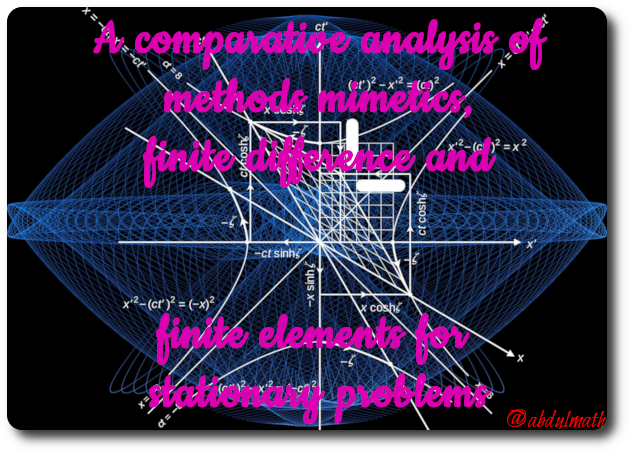


The finite difference method and the finite element method are the most used numerical methods to obtain solutions of problems that appear in many applications, which are modeled by partial differential equations. In the past few years a growing interest has been focused on conservative finite difference schemes, originally known as operators support and then as mimetic methods [4, 9, 10, 13]. In [6, 7] were shown that the mimetic method exhibits a better performance than the finite difference method.
The finite difference method and the finite element method exhibit advantages and disadvantages depending of the problems that we are facing up. Despite of the drawbacks of the finite element method the last one still prevail in applications nowadays, and in those applications where the finite difference method is much suitable, the standard finite element method has been modified in order to optimize the performance. For instance in problems of fluid dynamics we refer the reader to [11, 12], in problems with discontinuous conductivity see [5]. In [1, 8], the authors compare the efficiency of the mimetic method with finite difference method, basically applying the methods to elliptic problems. To our knowledge the comparison between the finite element method and the mimetic one, so far has not been studied. The experts coincide that this is a hard problem due to the high complexity that arise from the point of view of computational implementation.
The main goal of this work is to compare the finite element method with mimetic one. More concretely, we focus our attention to: convergence, tune up the precisions on the boundary conditions, flexibility in the implementation and computational cost. All the analysis is performed around of the convection diffusion equations for one dimensional stationary problems. In this studied we are going to involve the known results about the comparison between the mimetic method and the finite difference method, in order to get a global chart of the finite difference method and finite element method versus the mimetic one.


Let us consider the following equation

subject to the boundary conditions

Basically the equation (1) describe the heat propagation via convection–diffusion in stationary regime. The function u(x) represents the temperature at a point x in Ω, k > 0 is the coefficient of thermic diffusion, ν is the convection or advection speed and f is scalar function that describes the existence of a source or sink for the problem. The real parameters {αi, βi, γi }, i = a, b, take different values depending of the boundary conditions, i.e. Dirichlet, Neumann or Robin boundary conditions.
It is worthwhile to point out that the solution to the equation (1) subject to the boundary conditions (2) can be obtained explicitly by analytical methods. Actually we will strongly use this fact in order to establish the comparison chart between the three already mentioned numerical methods.


In this section we briefly describe the three methods that we will use along this investigation. The readers interested in more detail about the mimetic method we refer to [9], about finite element method see [3, 15] and the finite different method see [14].

The mimetic methods are based on the discretization of the classical operators: divergence, gradient and curl, assuming that the discretization must satisfy a discrete version of generalized Gauss’s theorem, i.e. the following identity must holds

Where, D, G and B are the discretizations of gradients (∇), divergences (∇·) and ∂/∂n, respectively. By using the identity (3) we obtaine the following relationship between the operators D, G and B

Let us define

where A = Q, or P or I, which are matrices obtained along de process of discretization.
Let us consider a mesh with is given by the nodes xi , with i = 0, 1, . . . , N, and cells [xi-1, xi], for i = 1, . . . , N. Assuming that the mesh is uniformly distributed, h = 1/N. The intermediate point of the cell is given by xi+1/2 = (xi + xi+1)/2. The solution of the problem (1)–(2) and the value of divergence are computed in the middle point of each cell, and the value of the gradient is calculated in the nodes; i.e. in xi. See figure attached.

One dimensional mesh for the mimetic method.
The mimetic method arising from a second order discrete operators introduced in [4] is given by formulae (5) and (6).
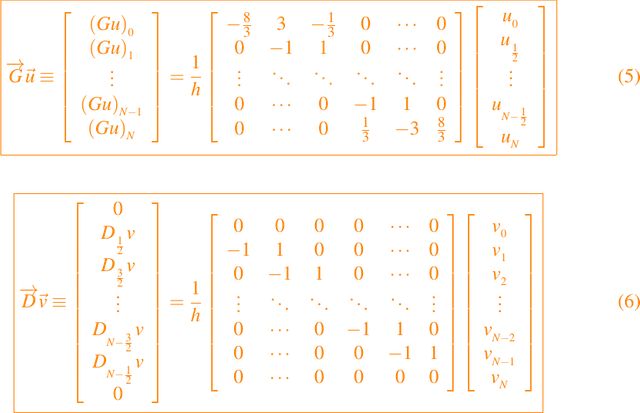
In (6) we add two rows identically equal zero. This is done for technical reason in order that de product between matrices be well defined.
The operator P and B are given by
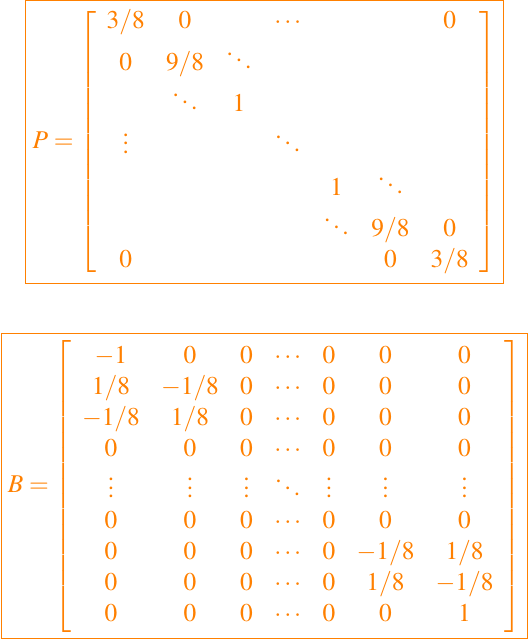
The discrete versions of the problem (1)–(2) by using the mimetic approach is given by

where U denote the so-called the mimetic solution to equation (7); i.e.

and F is given by

Take into account that the divergence does not play any role on the boundary conditions, we obtain that the Robin boundary conditions is given by

where the vector fb = (γa, 0, . . . , 0, γb)t. Matrices [α] and [β] are such that
α1,1 = αa, αN+2,N +2 = αb, β1,1 = βa, βN +2,N +2 = βb
and the other entries are equal zero.
Finally, from (7) and (8) we obtain the mimetic scheme for our problem which is given by


Basically, the finite differences method consist in the discretization of the differential operators involved in the problem, assuming that the mesh consist in N + 1 nodes, namely xi, see figure attached

One dimensional mesh for the finite difference method.
We obtain the following formulae for the first an second derivatives of the solution of the problem

Now, restricting our attention to the equation (1) with Robin boundary conditions (2) the finite difference method give us the following scheme for the computation of the numerical solution of the problem (1)–(2)

where Ai = ki − νi(h/2), Bi = ki + νi(h/2), for i = 1, . . . , N + 1.

Let us assuming, that we already have defined a concrete problem. The finite element method consists in looking for the solution of that problem in the form

where the coefficients ai are unknown and have to be determined along of an iterative process. The functions φi are a base for a finite–dimensional space VH ⊂ V , and V is a suitable space where we are going to solve the weak or variational form of the following problem, in our case we choose V the Sobolev space H1(Ω)

where the bilinear form B(u, v) and the linear functional l(v) are given by, respectively

where θa and θb are given by



Let us remind that we are dealing with the problem (1)–(2) on the domain Ω = (0, 1). Along this work we are going to estimate the error in computations by using the following norms
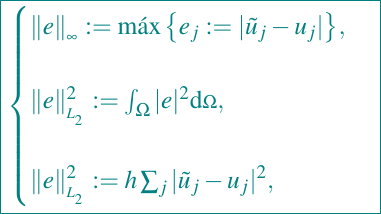
i.e., the norms of the spaces L∞ and L2 the continuous and discrete version (see [2]). ũj denotes the numerical solution obtained by each of the above mentioned numerical methods and uj denotes the exact solution of the problem (1)–(2). For the finite difference methods and finite element methods j = 1, . . . , n - 1. For the mimetic methods j = i + 1/2, with i = 0, · · · , n - 1.

Let us solve the problem (1)–(2) with diffusion coefficient k = 1, convective velocity ν = 0, Robin boundary conditions
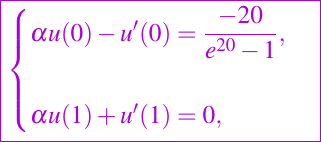
where

and the source term f(x) is defined in such a way that the exact solution (the black curve in the graphics) is given by

In the following figure, we exhibit the graphic of the exact solution versus the numerical solutions obtained by using the three numerical methods mentioned. The grid is chosen uniformly distributed formed by 20 nodes.
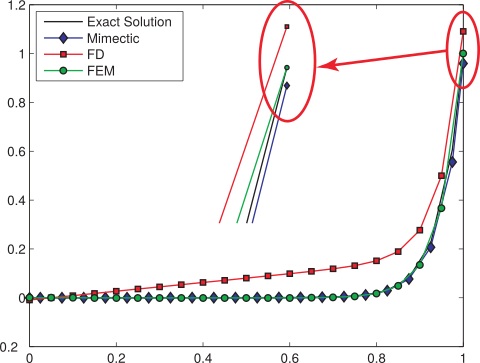
Comparison of the approximate solutions on a 20 mesh nodes. At the border, the FEM precision than in the
other two schemes.
Let us point out that in x = 1, i.e. in the right border, the finite difference methods loose accuracy, even by using second order scheme in order to approximate the boundary conditions. This pathology remains even increasing the number of nodes of the grid and changing the coefficients values k and ν. The three methods give us is suitable approximation when the problem (1) is subject to Dirichlet boundary conditions. The described situation is depicted in the zoom up (see the red oval in figure) of the behavior of the numerical solutions closed to the boundary x = 1.
In the following figure we sketch the magnitude of the errors performed by the three methods that we are using along this work. In the left graphic the error is measure by using the norm of L∞ and in the right one, we use the norm of L2. In both graphics below the slopes of the straight line mean the convergence order of each numerical method; the best resolve is achieved minimizing the value of the slopes.
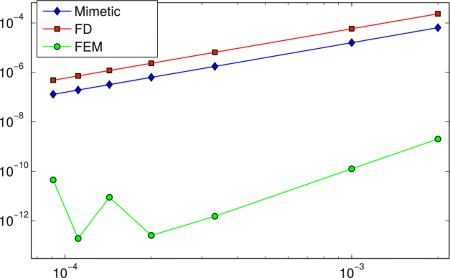 | 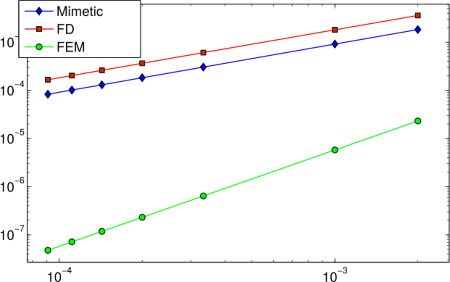 |
|---|---|
In the chart folowing, we show the theoretical order of convergence of the numerical methods in the norm of L∞ and in the norm of L2 .

Order of convergence in norm L∞ and norm L2.
However, the maximum norm for this problem, the finite element method has a superconvergence reaching ε machine. Therefore, the oscillations having the graph to the case of finite element method is due to rounding errors rather than machine precision loss finite element method. This feature is not held in other configurations of the problem as will be seen later. The norm L2, the finite element method has a second order in their convergence (as expected, see [15]), while the other two methods have a first order convergence (see figure and chart previous).

Once again, let us consider the problem (1)–(2), where the diffusion coefficient is given by

the convective velocity is ν(x) = k'(x), with α = 250 and x0 = 0.75, and the Robin boundary conditions are given by

The function f(x) is determined in such a way that the analytical solution of our problem is

In the following graphic on the left we compare the exact solution versus the approximating one by using a uniform grid formed by 60 nodes. In the other graphic two de right hand side, we ilustrate the asymptotic convergence of the approximating solutions closed to x = 1, as h → 0.
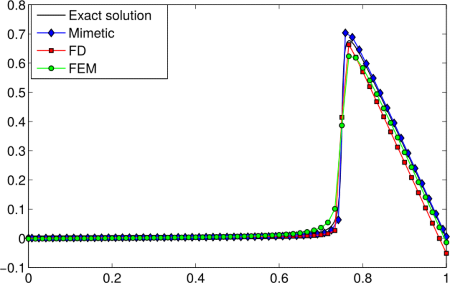 | 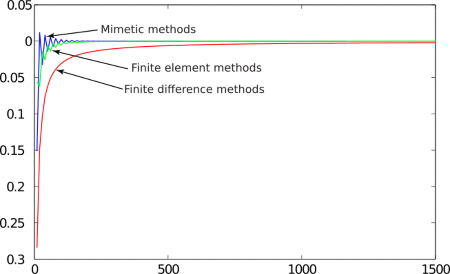 |
|---|---|
Let us point out that when the grid is formed just by a few nodes the approximating solutions obtained by mimetic methods exhibits a little bit accuracy over the approximating solutions obtained by the finite element method. In order that the finite difference method can exhibit a better performance in comparison with the two other methods, the grid has to be formed by at least 1500 nodes. If in (13) we set u(0) = u(1) = 0, the best approximating solutions of our problem is obtained by the finite element method.
In the figure and following chart we depict the comparison of the error and convergence order performed by the three methods that we are using along this research. Let us remarks that by using the norm of L∞ to measure the error and the convergence order the finite difference method decrease the order of convergence. This fact is due to that the diffusion and convective coefficients depend of the spatial variable. Despite of this the mimetic methods and finite element method preserve the order of convergence. By using the norm of L2 and performing the same analysis carried out above, we basically obtained the same results.
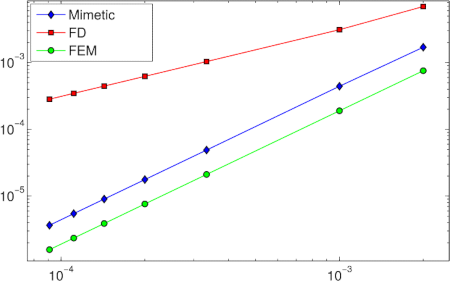 | 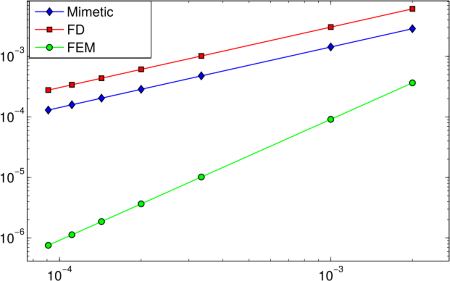 |
|---|---|

Order of convergence in norm L∞ and norm L2.

In this section, we are going to consider the problem (1)–(2), setting k = 1.052, ν = −110.5 and f ≡ 0. In this configuration the exact analytical solution is given by

with λ = ν/k. In the numerical implementation we choose the Dirichlet boundary condition u(0) = 0 and u(1) = 1 and in the second experiment the boundary conditions are of the Robin’s type, i.e.
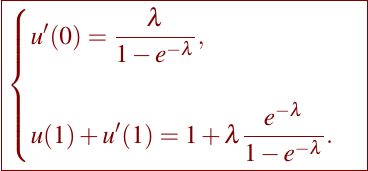
For the problem (1)–(2) with Dirichlet boundary conditions, it is well known that finite difference and finite element methods give us more or less the same result; exhibiting both methods oscillations if the Peclet’s number satisfy that

In other words the numerical methods are producing spurious solutions. In order to overcome this drawbacks is by taken h small enough or by adding artificially a diffusion coefficient. It is worthwhile to point out that when the Peclet’s number is less or equal one both methods do not exhibit this pathology on the contrary that Batista and Castillo asserted in [2].
In the following figures we depict the solutions obtained by using a uniform grid with 50, 80 and 200 nodes, respectively. From the numerical experiments turn out that the appearence of oscillations depends of the number of nodes of the grid, by increasing the number of nodes the mimetic methods give us a suitable approximating solution wich uniformly convergences to the exact solution.
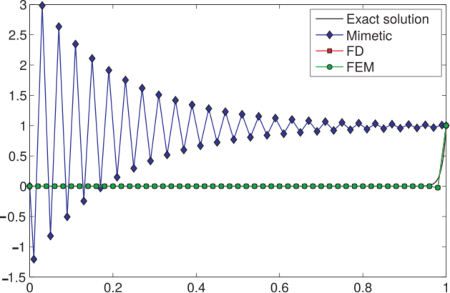 | 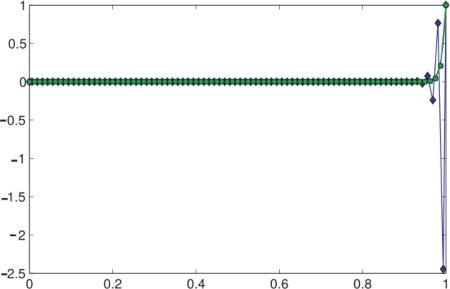 |
|---|---|
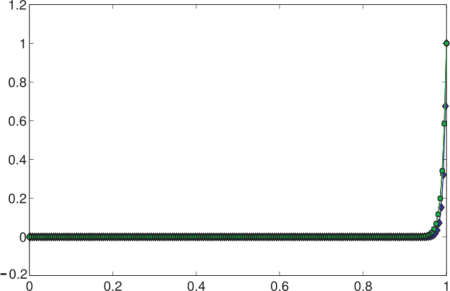 |
|---|
In the figure and following chart it is shown the errors and the order of convergence performed by the three involved numerical methods subject to Dirichlet boundary conditions. By using the norm of L∞ the finite difference and finite element methods exhibit more or less the same behavior and maintain the convergence order two. However the mimetic method loses the convergence order two and in comparison with the two other methods his performance is much weak. By usin the norm L2 the finite difference method and the mimetic method show an order of convergence one. The finite element method in the norm L2 preserves the convergence order two and ones again his performance is much robust. Comparing these results with those one obtained in the example 2, it is quite clear that the same advantages and drawbacks of the methods prevails.
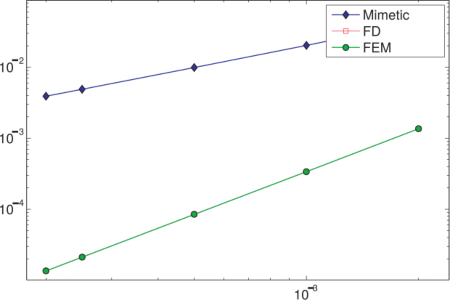 | 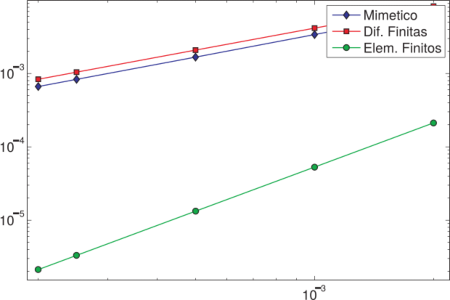 |
|---|---|

Order of convergence in norm L∞ and norm L2.
Let us consider the problem (1)–(2) subject to the Robin’s boundary conditions. The result of the numerical implementation of this problem is exhibit in figure following. In x = 1 the finite difference method and mimetic method exhibit a very poor performance, as it is shown in the zoom up of the graphics. The mimetic method in some cases needs even 4000 nodes in order to reach the precision of the finite element method wich just need 80 nodes in the grid. The finite difference method loose the precision at x = 1, and the method diverges.
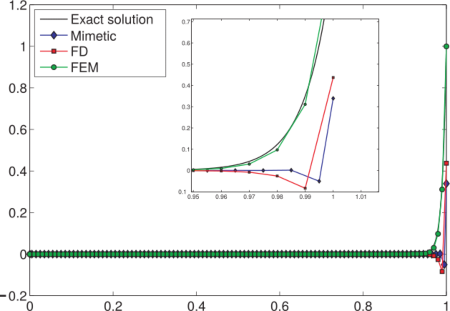 | 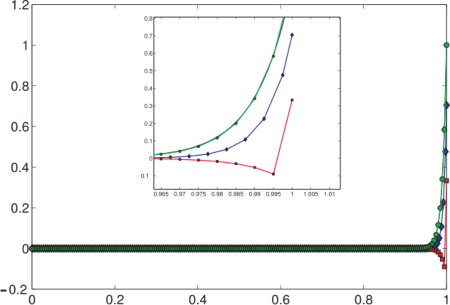 |
|---|---|


First of all we point out that finite element method exhibits a better precision in obtaining the numerical solution as well with the convergence order than the other two methods. Moreover the mimetic method exhibits a better performance than finite difference method. This fact has been mentioned by difference researchs [1, 7, 8]. In the example three the mimetic method can not reach a better performance than the others method, on the contrary that we would expected due to the conservative character of the mimetic method.
From the research it follows that much work has to be done in this direction. The mimetic and the finite difference methods prevail over the finite element method for problems in one dimensional spaces. Basically this fact is due to that the mimetic and finite difference methods are much easiest their numerical implementation. However in higher dimensions, even in two dimensional spaces, the three methods present a great difficulties in the discretization process. Moreover if we want to increase the convergences order arise a lot new difficulties.


- J. Arteaga and J.M. Guevara. A conservative finite difference scheme for static diffusion equation. Divulgaciones Matemáticas, 16(1):39–54, 2008.
- E.D. Batista and J.E. Castillo. Mimetic schemes on non-uniform structured meshes. Electronic Transactions on Numerical Analysis, 34(1):152–162, 2009.
- Eric B. Becker, Graham F. Carey, and J. Tinsley Oden. Finite Elements: An Introduction. Prentice-Hall, Inc., New Jersey 07632, 1981.
- J.E. Castillo and R. D. Grone. A matrix analysis approach to higher-order approximations for divergence and gradients satisfying a global conservation law. SIAM J. Matrix Anal. Appl., 25(1):128–142, 2003.
- F. Cordero and P. Dı́ez. XFEM+: una modificación de XFEM para mejorar la precisión de los flujos locales en problemas de difusión con conductividades muy distintas. Revista Internacional Métodos Numéricos para Cálculo y Diseño en Ingenierı́a, 26(2):121–133, 2010.
- M.A. Freites. Un estudio comparativo de los métodos miméticos para la ecuación estacionaria de difusión. Tesis de grado, Facultad de Ciencias, UCV, 2004.
- Juan M. Guevara, M. Freites, and J.E. Castillo. A new second order finite difference conservative scheme. Divulgaciones Matemáticas, 13(1):107–122, 2005.
- Juan M. Guevara. Sobre los esquemas miméticos de diferencias finitas para la ecuación estática de difusión. Trabajo de ascenso, Facultad de Ciencias, UCV, Caracas, Venezuela, 2005.
- James M. Hyman and Mikhail Shashkov. The approximation of boundary conditions for mimetic finite difference methods. Computers Math. Applic., 36(5):79–99, 1998.
- James M. Hyman, Mikhail Shashkov, and S. Steinberg. Mimetic finite difference methods for diffusion equations. Computers Math. Applic., 6(3-4):333–352, 2002.
- Ben Q. Li. Discontinuous Finite Elements in Fluid Dynamics and Heat Transfer. Springer-Verlag, London, fifth edition, 2006.
- Béatrice Rivière. Discontinuous Galerkin Methods for Solving Elliptic and Parabolic Equations: Theory and Implementation. SIAM, Philadelphia, fifth edition, 2008.
- Mikhail Shashkov and Stanly Steinberg. Support-operator finite-difference algorithms for general elliptic problems. Journal of Computational Physics, 118(1):131–151, 1995.
- John C. Strikwerda. Finite Difference Schemes and Partial Differential Equations. SIAM, Ltd., Philadelphia, second edition, 2004.
- Pavel Šolı́n. Partial Differential Equations and Finite Element Method. John Wiley & Sons, Ltd., New Jersey, fifth edition, 2006.
- Giovanni Calderón y Abdul Lugo, Estimación del error y adaptatividad en esquemas miméticos para problemas de contorno, Boletin de la Asociación Matemática Venezolana, 22(2):109–124. 2015.
- Abdul Lugo, Generación de mallas óptimas basadas en equemas de discretización mimética para problemas de contorno, Tesis de Doctorado, Facultad de Ciencias, Universidad de Los Andes, Venezuela.
- Abdul Lugo, Adaptatividad de soluciones usando esquemas miméticos en mallas adaptadas en movimiento. Preprint. 2017.

The separators and equations were created and edited by @abdulmath using free software, GNU Octave,  , GIMP and Inkscape.
, GIMP and Inkscape.

I am not familiar with the mimetic method so I have a number of questions:
Are there any theoretical results which prove the convergence of the mimetic method for a specific set of equations?
How do stability results compare?
I also have one suggestion: The steemstem community has a low percentage of individuals with a strong mathematical background. So for most of the community it is not possible to fully enjoy your posts. To increase your audience and to further promote your work, you could consider to write a simple version of your research results. Would you be interested in that?
Hello @mathowl, thanks for commenting and asking about aspects that you do not know.
If there are theoretical results with respect to the convergence of the method, for conservative type equations.
The method is stable.
Regarding your suggestion: I have seen that when the works I publish are quite simple, they are valued with a very small percentage. That is why I try to raise the level of them. But because of his suggestion he would have no problem doing.
Also, since he tells me that they have few people in the community with a solid mathematical background, I offer my collaboration, if you deem it convenient, to review the work in the area of mathematics, and thus be able to return the collaboration to your.
Motivated by your questions, I will elaborate some publications about the mimetic method, as well as details of its construction, as well as the study of the convergence for some type of equations.
Thankful for your comments.
Best regards.
Follow up question for 2) Is it possible to prove stability?
Regarding suggestion: You can still treat complicated subjects but try to explain them in an informal way as possible since there are not many which can understand the technicalities. :)
If it is possible to prove the stability of the method!
I will take your suggestions!
Well my friend, what can I tell you? even when I read what you wrote here, I could not understand nothing what you are talking about.
However I like your post.
Regards friend.
Hello @ alarconr22.arte very grateful to visit my blog and try to understand the subject a bit, the truth if you do not work in that area will be complicated.
Greets and a hug.
I congratulate you for your contribution to this wonderful network, which feeds on quality content with your effort. I don't have much level in my vote, but if I have the criteria that your work is very good, you detail the processes, and graphically show the whole set of equations. With respect to the design, you take care that everything you show is from your own source and is also very pleasant to read. My most sincere congratulations.
Good vibes.
Hello @ angelica7
Very grateful for such nice comments about my publication and my previous work.
Best regards.
Congratulations @abdulmath! You have completed the following achievement on the Steem blockchain and have been rewarded with new badge(s) :
Click on the badge to view your Board of Honor.
If you no longer want to receive notifications, reply to this comment with the word
STOPDo not miss the last post from @steemitboard:
Congratulations! This post has been upvoted from the communal account, @minnowsupport, by abdulmath from the Minnow Support Project. It's a witness project run by aggroed, ausbitbank, teamsteem, someguy123, neoxian, followbtcnews, and netuoso. The goal is to help Steemit grow by supporting Minnows. Please find us at the Peace, Abundance, and Liberty Network (PALnet) Discord Channel. It's a completely public and open space to all members of the Steemit community who voluntarily choose to be there.
If you would like to delegate to the Minnow Support Project you can do so by clicking on the following links: 50SP, 100SP, 250SP, 500SP, 1000SP, 5000SP.
Be sure to leave at least 50SP undelegated on your account.
Good work, brother...
Thanks.
This post has been voted on by the SteemSTEM curation team and voting trail in collaboration with @curie.
If you appreciate the work we are doing then consider voting both projects for witness by selecting stem.witness and curie!
For additional information please join us on the SteemSTEM discord and to get to know the rest of the community!